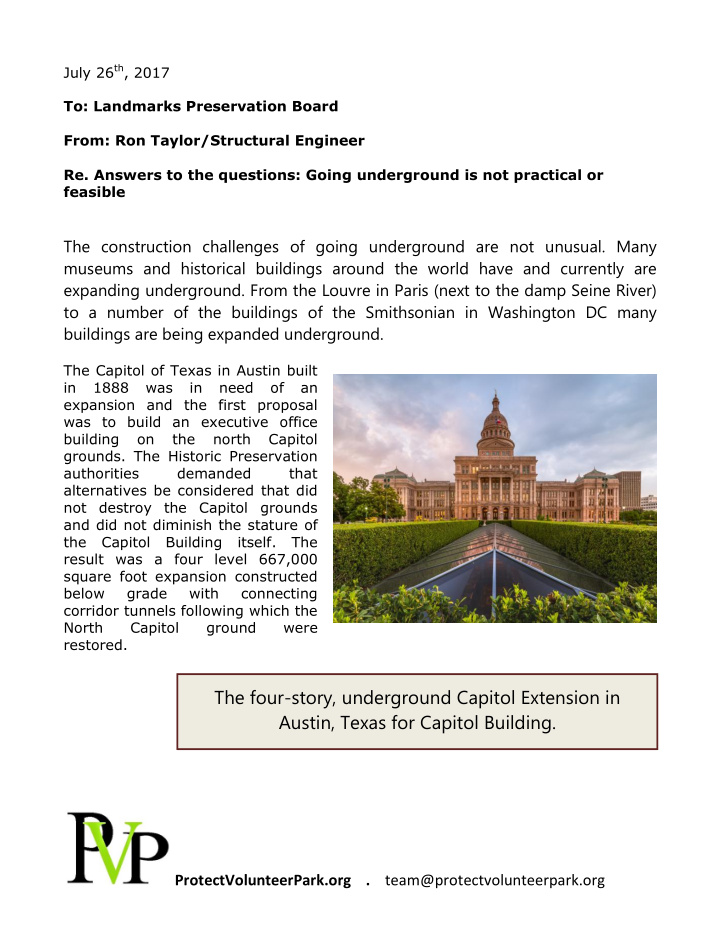



July 26 th , 2017 To: Landmarks Preservation Board From: Ron Taylor/Structural Engineer Re. Answers to the questions: Going underground is not practical or feasible The construction challenges of going underground are not unusual. Many museums and historical buildings around the world have and currently are expanding underground. From the Louvre in Paris (next to the damp Seine River) to a number of the buildings of the Smithsonian in Washington DC many buildings are being expanded underground. The Capitol of Texas in Austin built in 1888 was in need of an expansion and the first proposal was to build an executive office building on the north Capitol grounds. The Historic Preservation authorities demanded that alternatives be considered that did not destroy the Capitol grounds and did not diminish the stature of the Capitol Building itself. The result was a four level 667,000 square foot expansion constructed below grade with connecting corridor tunnels following which the North Capitol ground were restored. The four-story, underground Capitol Extension in Austin, Texas for Capitol Building. ProtectVolunteerPark.org . team@protectvolunteerpark.org
The very tiny Museo del Romanticismo in Madrid built in 1776 was in need of extra storage and locker space. In 1996 the courtyard and garden were excavated and the expansion built under ground with the garden and courtyard being replaced. Museo del Romanticismo In Madrid expanded under a courtyard. All throughout Spain the museums have expanded underground! The famous Prado in Madrid needed expansion space and instead of building new construction in one of the open park spaces surrounding the classic building, the expansion was built substantially underground as depicted in photo below. Prado Art Museum in Madrid expanded underground. ProtectVolunteerPark.org . team@protectvolunteerpark.org
Conce el Centro Art Museum in Granada expanded underground. The small art museum Conce el Centro in Granada was in need of more gallery space. This was obtained by excavating under the adjoining square and under the existing building and the resulting space is shown in the photo above. The public square was restored. All these examples from around the world illustrate clearly that it is possible and practical to build underground. And in all these cases prime public space and park spaces were not required to be sacrificed for the expansions. ProtectVolunteerPark.org . team@protectvolunteerpark.org
The outdoor amphitheater at the famous Alhambra in Granada Spain was in need of more backstage space. It was build underground as shown. No public space was taken up. The Alhambra Amphitheater in Granada Spain also expanded underground. Here in Seattle with Volunteer Park and the Gould building we have arguably the finest park and building site in the city, and it seems unimaginable that an underground solution to the requested expansion of SAAM is not being considered. To build into this valuable park space with a building addition that seems to have no connection with the historic original building is difficult to understand. It appears that rather the “powers that be” are simply, as Sam Rayburn once said, going along to get along . If this is the process that is going on here then my humble opinion is that you are being Intellectually Dishonest . ProtectVolunteerPark.org . team@protectvolunteerpark.org
In conclusion do we want something like this? Or do we want more of this? ProtectVolunteerPark.org . team@protectvolunteerpark.org
Saving landmarks and parkland and open space is a universal issue… Other Museums around the world which have successfully expanded underground: Bowdoin College Museum of Art in Brunswick, ME The Frick Collection Art Museum in New York City, NY The Freer and Sackler – Asian Art Museums on Smithsonian campus WA, DC. Louvre Art Museum in Paris, France. Philadelphia Museum of Art in Pennsylvania Phipps Conservatory and Botanical Gardens in Schenley Park, Pittsburgh, PA U of Pennsylvania Museum of Archaeology and Anthropology Staedel Art Museum in Frankfurt, Germany Palace of Legion of Honor Art Museum in San Francisco, California Four-story, underground Extension in Austin, Texas for Capitol Building. National Museum and Dialogue Center in Szczecin, Poland Underground Painting Gallery by Philip Johnson in New Canaan, CT. Royal Picture Gallery Mauritshuis in The Hague British Museum in London The Morgan Library & Museum in New York City Cooper Hewitt, National Design Museum, in New York City Ron Taylor is a structural engineer with a business degree. He has worked in the construction business for over 40 years, the last 25 as CEO, in the US and Canada plus internationally. In North America he has worked on commercial and institutional construction projects from the Arctic coast to Florida and from New England to California. Major restoration projects have included the interior restoration of the Texas Capitol, and conversion of the Tacoma Union Station into a Federal Courthouse among others. Respectfully submitted, Ronald E Taylor 1233 Federal Avenue East, Seattle WA 98102 ProtectVolunteerPark.org . team@protectvolunteerpark.org
Recommend
More recommend